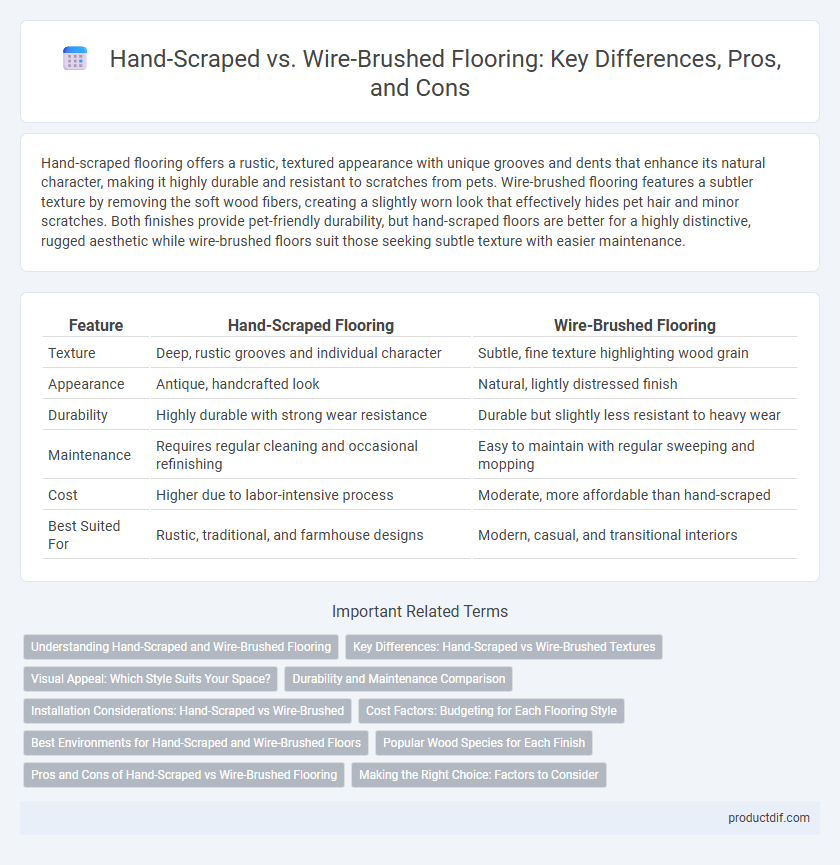Hand-scraped flooring offers a rustic, textured appearance with unique grooves and dents that enhance its natural character, making it highly durable and resistant to scratches from pets. Wire-brushed flooring features a subtler texture by removing the soft wood fibers, creating a slightly worn look that effectively hides pet hair and minor scratches. Both finishes provide pet-friendly durability, but hand-scraped floors are better for a highly distinctive, rugged aesthetic while wire-brushed floors suit those seeking subtle texture with easier maintenance.
Table of Comparison
| Feature | Hand-Scraped Flooring | Wire-Brushed Flooring |
|---|---|---|
| Texture | Deep, rustic grooves and individual character | Subtle, fine texture highlighting wood grain |
| Appearance | Antique, handcrafted look | Natural, lightly distressed finish |
| Durability | Highly durable with strong wear resistance | Durable but slightly less resistant to heavy wear |
| Maintenance | Requires regular cleaning and occasional refinishing | Easy to maintain with regular sweeping and mopping |
| Cost | Higher due to labor-intensive process | Moderate, more affordable than hand-scraped |
| Best Suited For | Rustic, traditional, and farmhouse designs | Modern, casual, and transitional interiors |
Understanding Hand-Scraped and Wire-Brushed Flooring
Hand-scraped flooring features uniquely textured planks crafted by artisans to mimic the look of aged, naturally distressed wood, offering a warm and rustic appearance. Wire-brushed flooring uses a mechanical wire brush to remove the softer wood grains, enhancing the natural grain patterns and creating a subtle, textured surface that hides scratches and wear. Both techniques provide durability and character, with hand-scraped emphasizing handcrafted detail and wire-brushed highlighting grain enhancement and surface resilience.
Key Differences: Hand-Scraped vs Wire-Brushed Textures
Hand-scraped flooring features intentionally uneven, irregular grooves and patterns created by artisans to mimic aged, rustic wood, offering a more authentic, handcrafted appearance. Wire-brushed flooring uses stiff wire brushes to remove the soft wood grain, resulting in a subtle textured surface with enhanced natural wood grain visibility and a smoother feel than hand-scraped finishes. The key difference lies in the depth and complexity of texture, with hand-scraped floors providing more pronounced, varied grooves, while wire-brushed floors maintain a consistent, refined texture that highlights the wood's natural character.
Visual Appeal: Which Style Suits Your Space?
Hand-scraped flooring offers a rustic, textured look with deep grooves that emphasize a handcrafted, vintage charm, perfect for traditional or cozy living spaces. Wire-brushed flooring provides a subtle, weathered effect with softer surface textures that showcase the wood's natural grain, ideal for modern and minimalist interiors. Choosing between the two depends on whether you prefer bold, tactile character or a refined, understated elegance in your flooring aesthetic.
Durability and Maintenance Comparison
Hand-scraped flooring offers superior durability due to its deeper texture that effectively conceals scratches and dents, making it ideal for high-traffic areas. Wire-brushed flooring features a lighter, more uniform texture that shows wear more quickly but requires less frequent intensive maintenance. Both finishes benefit from regular sealing to extend lifespan and maintain appearance, but hand-scraped surfaces typically demand more careful cleaning to preserve their rugged character.
Installation Considerations: Hand-Scraped vs Wire-Brushed
Hand-scraped flooring requires precise installation techniques to preserve its unique texture and avoid damage to the handcrafted surface, often demanding more time and specialized skills. Wire-brushed flooring, being less delicate, allows for easier installation and is generally more forgiving with subfloor imperfections, making it suitable for DIY projects. Both types benefit from acclimation to room conditions and moisture control to ensure long-term durability and stability.
Cost Factors: Budgeting for Each Flooring Style
Hand-scraped flooring generally commands a higher price due to the labor-intensive process that creates its distinctive textured surface, making it a premium choice for budget-conscious projects. Wire-brushed flooring offers a more affordable alternative by using mechanical tools to create subtle grooves that enhance wood grain without extensive manual labor. Evaluating initial material costs, installation fees, and long-term maintenance expenses helps accurately budget for each flooring style in residential or commercial applications.
Best Environments for Hand-Scraped and Wire-Brushed Floors
Hand-scraped floors excel in rustic or traditional settings where their textured, uneven surface enhances character and hides imperfections, making them ideal for high-traffic areas like living rooms and entryways. Wire-brushed floors suit modern or contemporary interiors, offering a subtle, distressed finish that reveals the wood's natural grain, perfect for spaces such as kitchens and dining rooms where durability and easy maintenance are essential. Both flooring styles are crafted from hardwood species like oak, hickory, or maple, ensuring resilience and longevity in various residential environments.
Popular Wood Species for Each Finish
Hand-scraped flooring often features hardwoods like hickory, oak, and maple, prized for their rustic, textured appearance that enhances natural grain variations. Wire-brushed finishes are commonly applied to species such as white oak, ash, and walnut, highlighting the wood's natural character by removing the softwood and emphasizing the tighter grain patterns. Each finish accentuates different wood properties, making the choice dependent on the desired aesthetic and durability.
Pros and Cons of Hand-Scraped vs Wire-Brushed Flooring
Hand-scraped flooring offers a distinctive, rustic appearance with deep texture that hides scratches and dents effectively, making it ideal for high-traffic areas, but it can be more expensive and requires professional installation. Wire-brushed flooring features a softer texture with subtle grain accentuation, providing a contemporary look and easier maintenance, yet it may show wear faster in heavily used spaces. Choosing between hand-scraped and wire-brushed depends on desired aesthetic, durability needs, and budget constraints.
Making the Right Choice: Factors to Consider
When choosing between hand-scraped and wire-brushed flooring, consider durability, aesthetic appeal, and maintenance requirements. Hand-scraped floors offer unique, rustic textures with deeper grooves that hide imperfections well, ideal for high-traffic areas. Wire-brushed floors provide a subtler, textured finish that enhances natural wood grain while requiring less intensive upkeep, suitable for modern and traditional spaces alike.
Hand-Scraped vs Wire-Brushed Infographic

 productdif.com
productdif.com